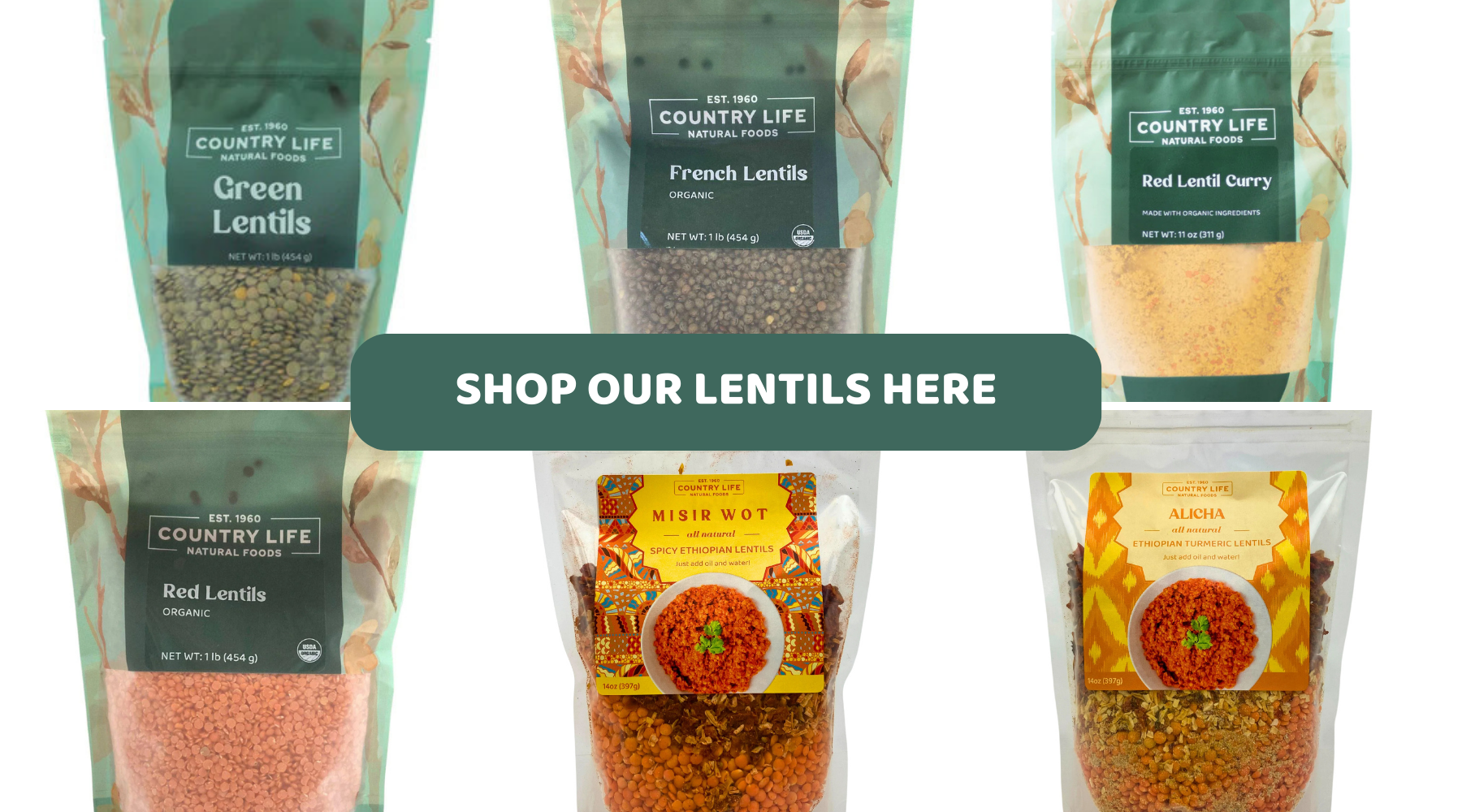learn to love your lentils
Knowing which lentils to choose and how to use them best, will make you fall in love with this cullinary staple all over again!
With so many types of lentils staring back at you from the grocery shelf, it’s easy to feel overwhelmed. You just want to make a simple lentil soup—why does it feel like such a big decision?
Okay, maybe that’s a bit dramatic, but when it comes to healthy eating, every choice matters! Lentils, tiny yet powerful nutritional heroes, have been a staple in kitchens worldwide for centuries. Not only do they cook faster than beans, but they also pack a serious punch in terms of protein, fiber, and essential nutrients.
Below you'll find six different types of lentils and uncover their unique qualities, one spoonful at a time!
BUY ORGANIC LENTILS
KEY TAKEAWAYS: 6 TYPES OF LENTILS
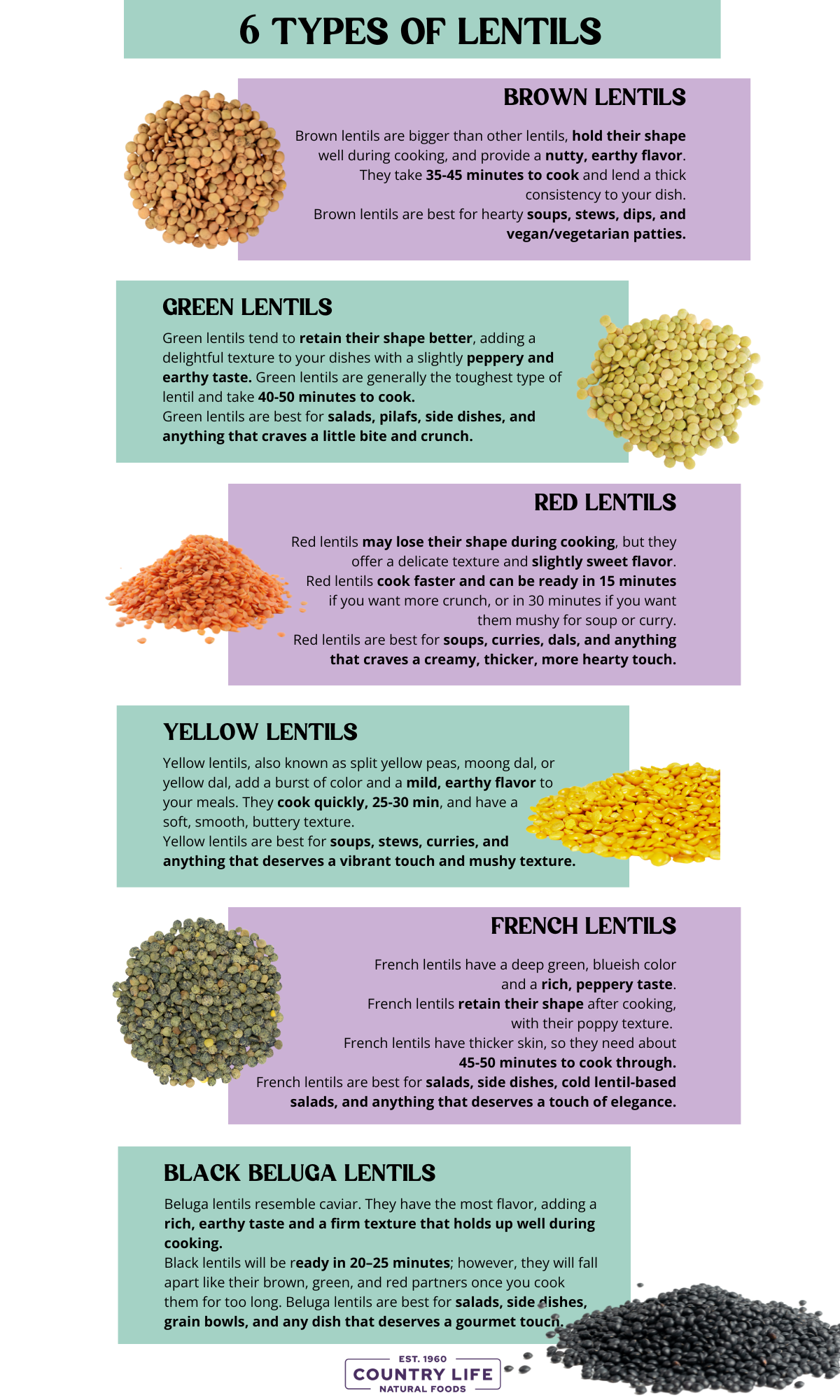
- Brown Lentils – The most common and versatile; mild, earthy flavor; slightly mushy when cooked. Best for: Soups, stews, veggie burgers.
- Green Lentils – Firm texture with a peppery taste; holds shape well. Best for: Salads, pilafs, side dishes.
- Red Lentils – Quick-cooking and slightly sweet; breaks down into a creamy consistency. Best for: Soups, curries, dals.
- Yellow Lentils – Mild, buttery, and smooth; cooks fast. Best for: Soups, stews, curries.
- French Lentils (Puy Lentils) – Firm texture with a deep, peppery flavor; takes longer to cook. Best for: Salads, gourmet dishes, side dishes.
- Black Beluga Lentils – Small, glossy, and rich in flavor; holds shape well. Best for: Salads, grain bowls, elegant dishes.
Keep on reading for more detailed info about these different types of lentils, along with their nutritional values per 100g.
We also share the benefits of eating lentils, which lentils are the healthiest, and how to include more lentils in your diet!
6 Types of lentils
brown lentils
The brown lentil is like your favorite pair of jeans—comfortable, versatile, and always in style. It's the favorite that everyone loves and uses most.
Brown lentils are bigger than other lentil types, hold their shape well during cooking, and provide a nutty, earthy flavor. Their color will range from khaki to dark brown. They are packed with essential nutrients like protein, dietary fiber, iron, and folate.
These stalwarts take 35-45 minutes to cook and tend to split and fall apart, lending a more mushy, thick consistency to your dish.
They're the perfect choice for hearty soups, stews, and even veggie burgers. Consider them your go-to in the plant-based kitchen!
Nutritional Value per 100g:
- Calories: 116
- Protein: 12g
- Carbs: 13g
- Fat: 0.6g
- Fiber: 9.2g
- Iron: 2.5mg
- Folate: 50mcg
- Potassium: 365mg
Brown lentils are best for hearty soups, stews, dips, and vegan/vegetarian patties.
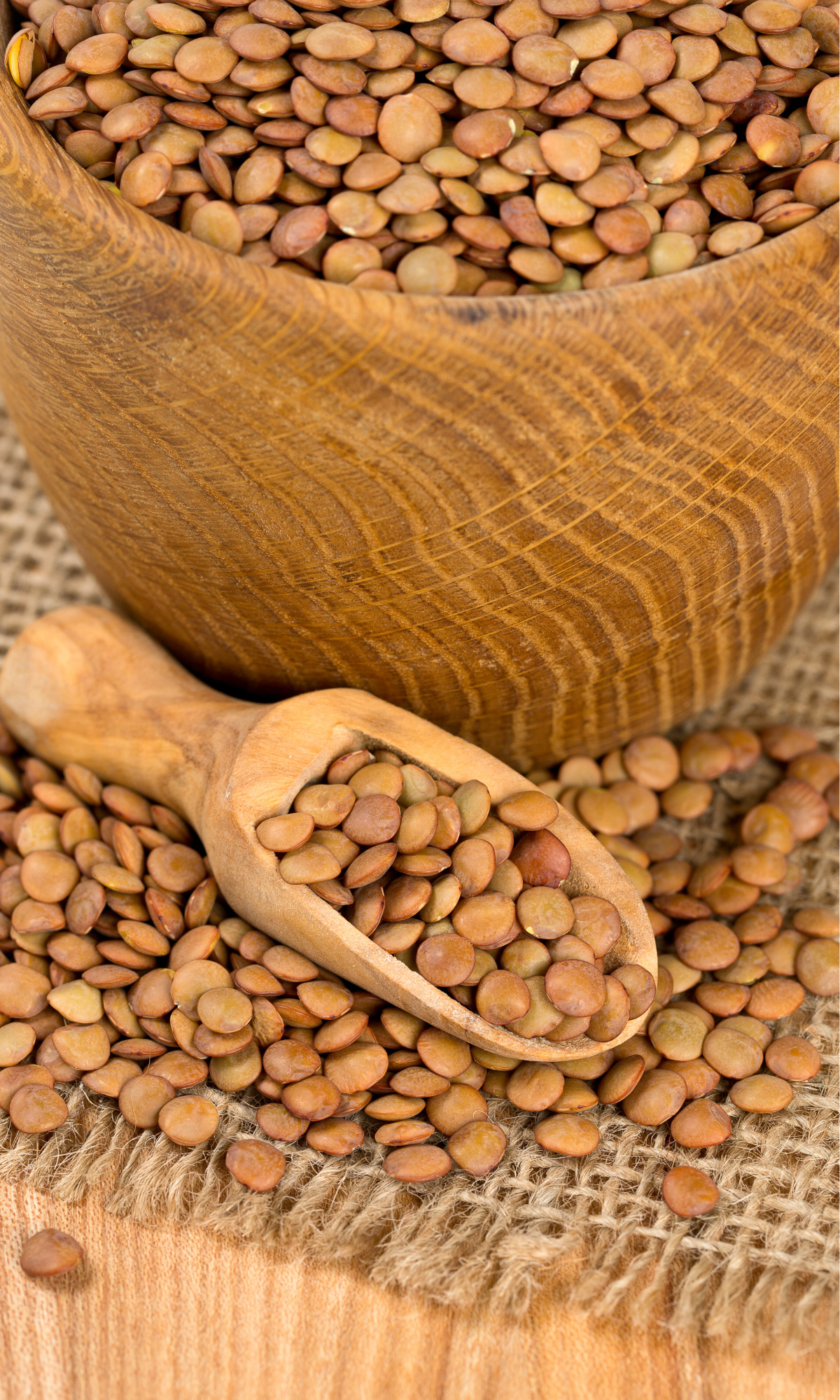
-v1686573220212.png?1440x2000)
green lentils
Consider green lentils your popular and health-conscious foodie friends!
Green lentils are often the most common type of lentil used. These trendy legumes are much like their brown counterparts but tend to retain their shape better, adding a delightful texture to your dishes.
With a slightly peppery and earthy taste, green lentils bring a refreshing twist to salads and pilafs. Green lentils are generally the toughest type of lentil and take 35-45 minutes to cook.
They are also rich in protein, dietary fiber, potassium, and vitamins.
Nutritional Value per 100g:
- Calories: 87.5
- Protein: 7g
- Carbs: 14g
- Fat: 1.4g
- Fiber: 7g
- Potassium: 245mg
Green lentils are best for salads, pilafs, side dishes, and anything that craves a little bite and crunch.
red lentils
Think of red lentils as your flamboyant and speedy culinary companions!
With their hues ranging from yellow to orange to red, red lentils make the perfect velvety base for soups, curries, and dals. These lentils may lose their shape during cooking, but they offer a delicate texture and slightly sweet flavor.
Red lentils cook faster than their counterparts. They can be ready in 15 minutes if you want more crunch, or in 30 minutes if you want them mushy for soup or curry. They're an excellent source of protein, dietary fiber, potassium, and B vitamins.
Nutritional Value per 100g:
- Calories: 350
- Protein: 24.5g
- Carbs: 59.5g
- Fat: 1.75g
- Fiber: 28g
- Potassium: 273mg
Red lentils are best for soups, curries, dals, and anything that craves a creamy, thicker, more comforting touch.
Red lentils are some of our favorites around here, especially our newest Ethiopian inspired lentils!
They consist of red lentils mixed with the perfect blend of spices, giving them an aromatic kick. Best of all, they are so easy and quick to prepare!
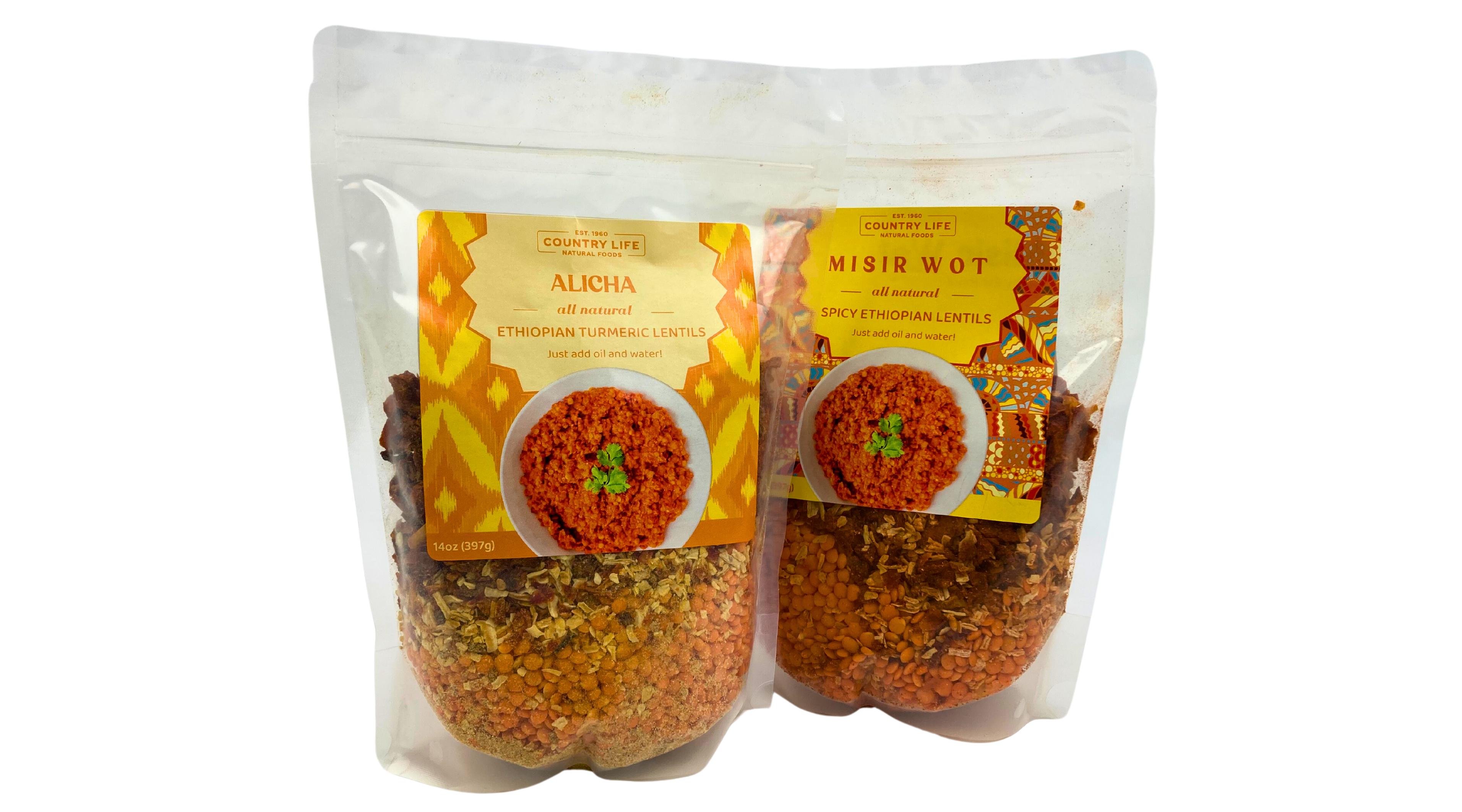
-v1686573482379.png?900x2000)
-v1686573151951.png?1440x2000)
yellow lentils
Think of yellow lentils as your jovial and time-saving kitchen buddies!
These cheery legumes add a burst of color and a mild, earthy flavor to your meals.
Yellow lentils, also known as split yellow peas, moong dal, or yellow dal, are tiny lentils created by skinning and splitting green mung beans. They cook quickly and have a soft, smooth, buttery texture, making them perfect for the base of soups and curries.
They are a fantastic source of protein, dietary fiber, potassium, and B vitamins.
Nutritional Value per 100g:
- Calories: 116
- Protein: 8.9g
- Carbs: 19.95g
- Fat: 0.4g
- Fiber: 7.8g
- Potassium: 369mg
Yellow lentils are best for soups, stews, curries, and anything that deserves a vibrant touch and mushy texture.
french lentils
French lentils are your sophisticated and health-conscious culinary comrades!
These elegant French lentils are from the Puy region in France, also known as Puy lentils. These petite green gems have a striking deep green, blueish color, and a rich, peppery taste.
With their poppy texture and lack of mushiness, French lentils retain their shape after cooking. This makes them ideal for side dishes, cold lentil-based salads, and stews and soups where you want that extra texture.
They boast an impressive nutritional profile with protein, high fiber content, iron, and folate.
French Puy lentils have thicker skin, so they need longer cooking, about 45-50 minutes to cook through.
Nutritional Value per 100g:
- Calories: 350
- Protein: 24.5g
- Carbs: 59.5g
- Fat: 3g
- Fiber: 31.5g
- Iron: 7.35mg
- Folate: 50mcg
French lentils are best for salads, side dishes, cold lentil-based salads, and anything that deserves a touch of elegance.
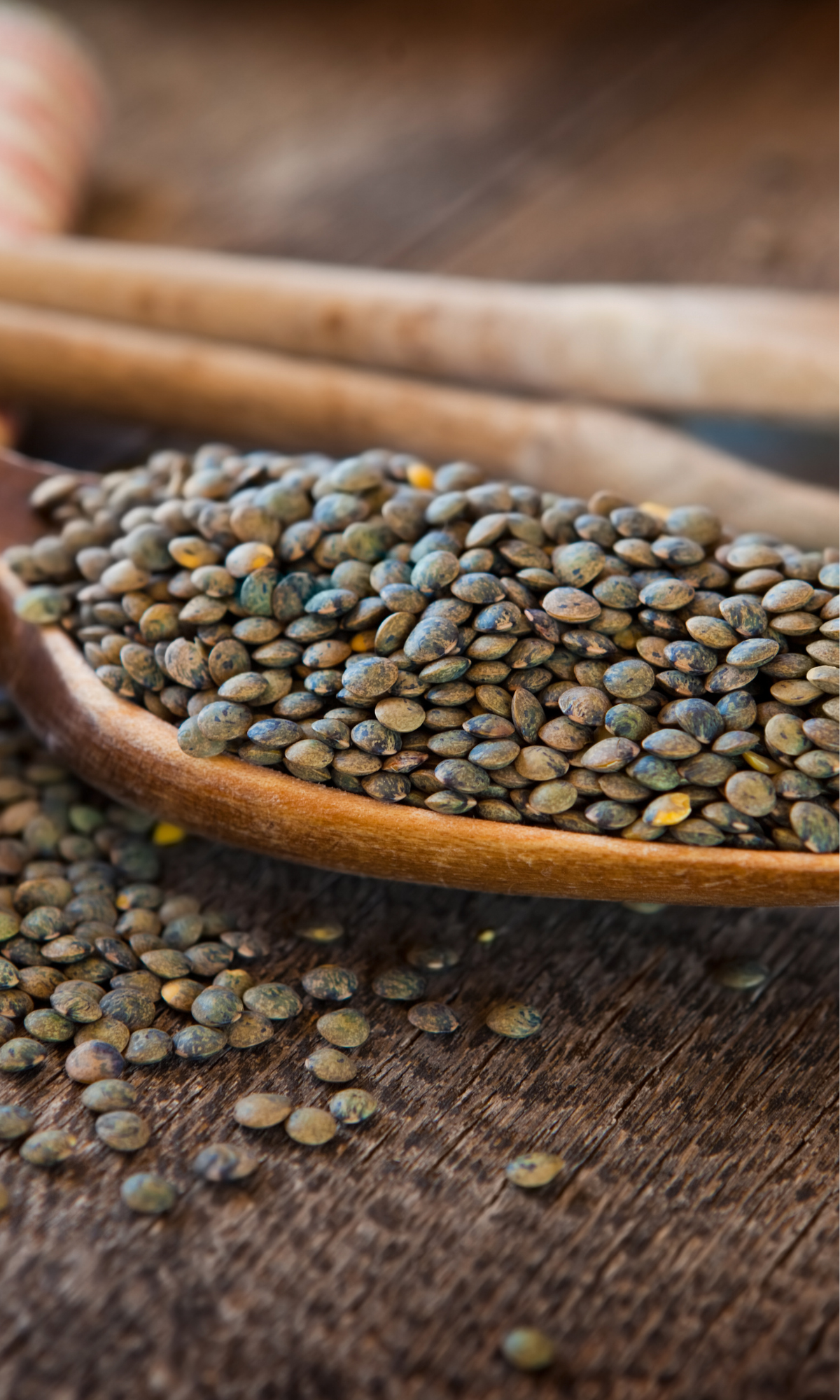
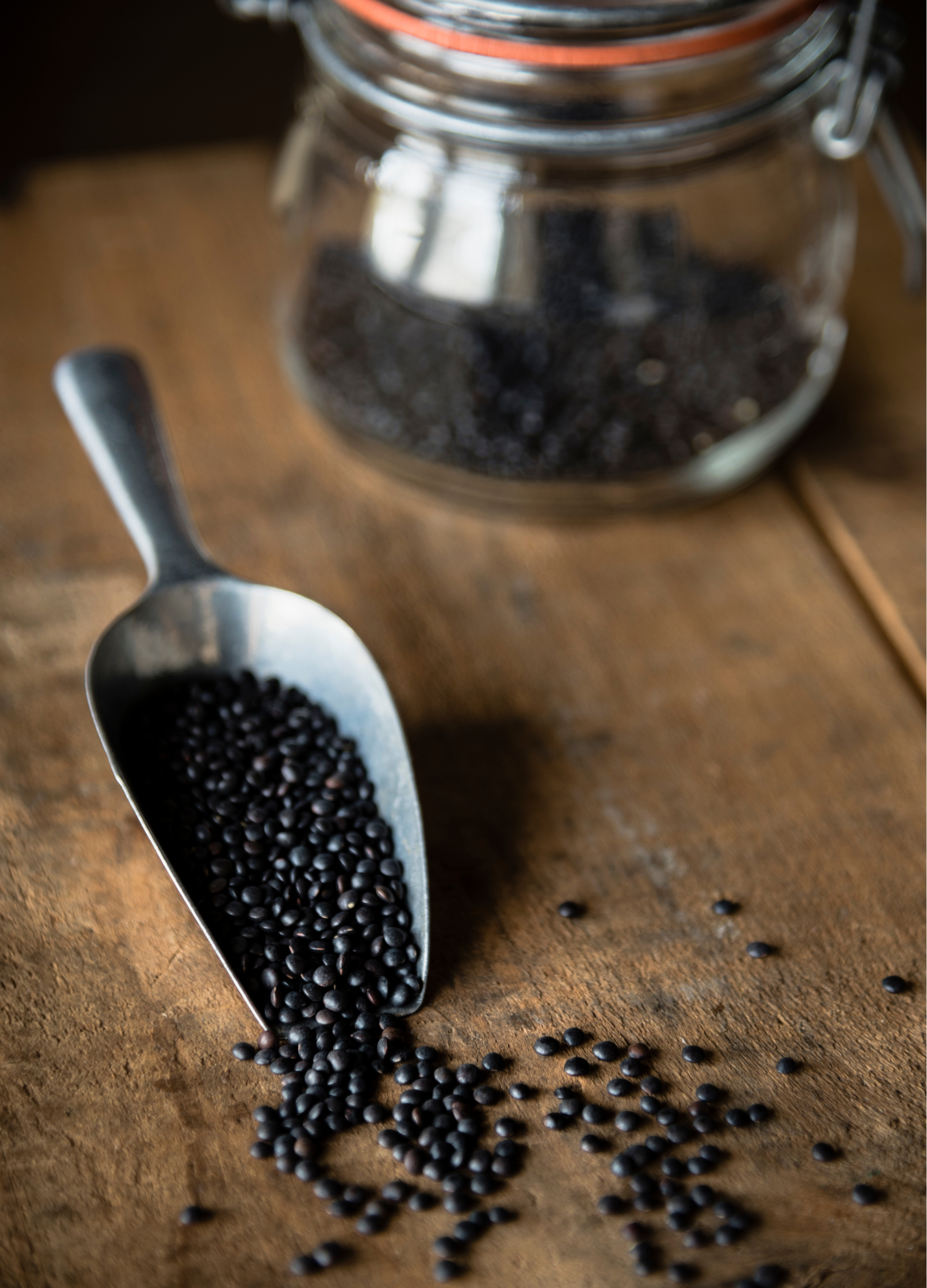
black beluga lentils
And now, introducing the dark knights of the lentil kingdom—Black Beluga lentils! They are sophisticated and mysterious, and will surprise anyone eating them!
These small, glossy gems resemble caviar, earning them the name "Beluga" after the famed black sturgeon roe. Their striking appearance adds a touch of elegance to any dish.
Black Beluga lentils have the most flavor, adding a rich, earthy taste and a firm texture that holds up well during cooking. Black lentils will be ready in 20–25 minutes; however, they will fall apart like their brown, green, and red partners once you cook them for too long.
They are a superb protein, dietary fiber, iron, and magnesium source. However, they are on the heavier side when it comes to calories, carbs, and fat.
Nutritional Value per 100g:
- Calories: 400
- Protein: 24g
- Carbs: 68g
- Fat: 6g
- Fiber: 18g
Beluga lentils are best for salads, side dishes, grain bowls, and any dish that deserves a gourmet touch.
WHICH LENTILS ARE THE HEALTHIEST?
This question is almost the same as asking which child is your favorite ;-) You cannot single one out, as they all have their unique qualities!
All lentils offer impressive health benefits, but if you’re looking for the most nutrient-dense option, here are some top contenders:
- Red Lentils: High in fiber (28g per 100g) and a great source of protein, making them a powerhouse for digestion and muscle health.
- Black Beluga Lentils: Packed with antioxidants, protein, and iron, these lentils are fantastic for heart health and overall wellness.
- French Lentils: Their high fiber and iron content make them excellent for digestion and energy levels.
- Brown and Green Lentils: While slightly lower in protein than other varieties, they still provide excellent fiber and essential minerals.
The healthiest lentils ultimately depend on your dietary needs and the type of dish you’re making. Whether you're seeking protein, fiber, or versatility, there’s a lentil variety to suit every meal!
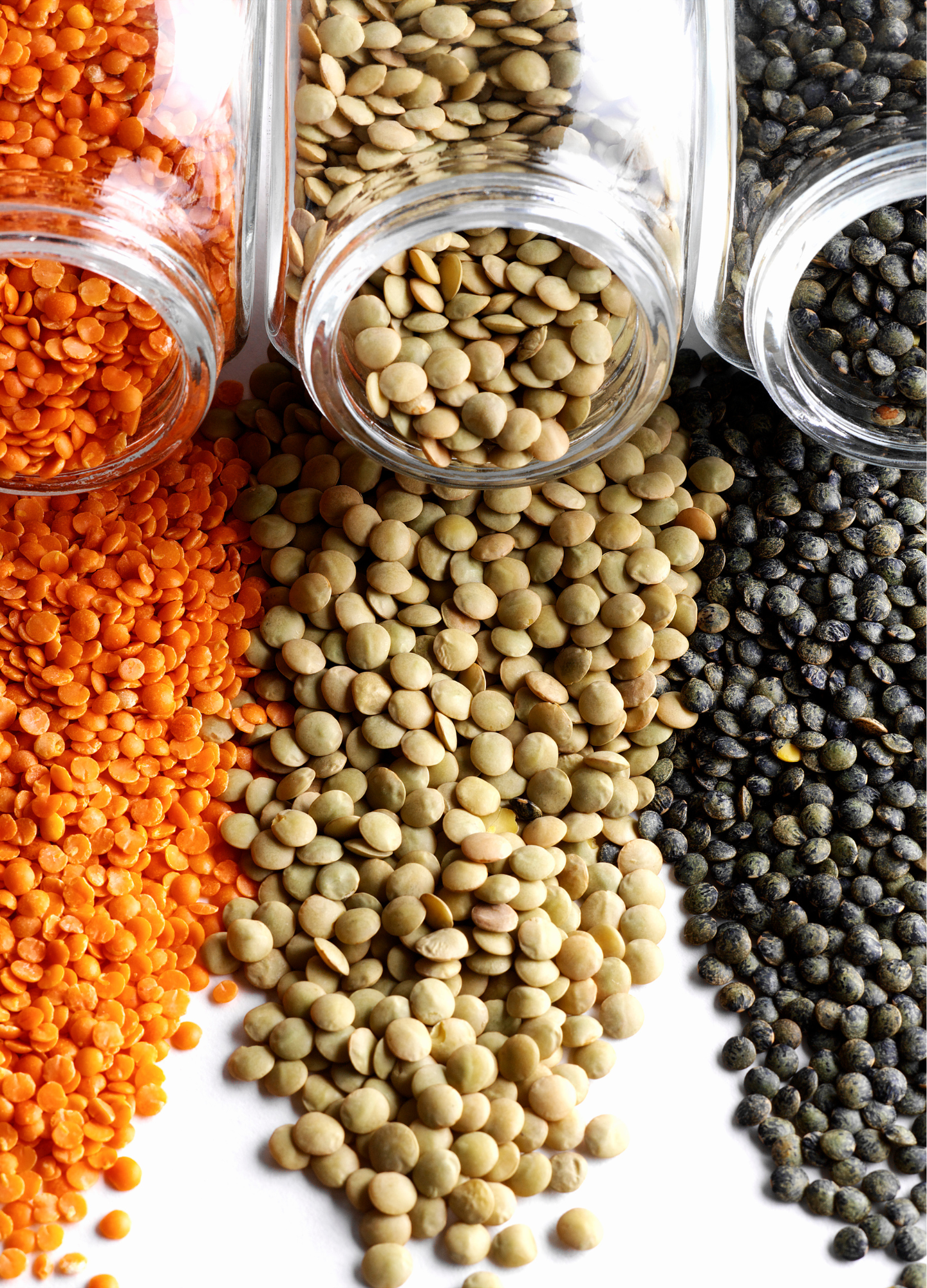
lentil health benefits
protein power
------Lentils are an excellent plant-based protein source, making them a perfect choice for vegetarians and vegans alike. They provide essential amino acids necessary for tissue repair and growth.
fierce fiber
------Lentils are bursting with dietary fiber, aiding digestion and promoting a healthy gut. They can help regulate blood sugar levels and keep you feeling full for longer, making them a great choice for weight management.
nutrient nuggets
------Lentils are rich in vital nutrients like iron, potassium, folate, manganese, and various vitamins, contributing to overall health and well-being.
heart heroes
------Regular consumption of lentils has been associated with reduced cholesterol levels and a decreased risk of heart disease. These legumes are low in saturated fats and high in heart-healthy nutrients.
diabetic derailer
------Regular consumption of germinated lentils is beneficial for preventing and managing diabetes. Lentils can improve blood glucose, lipid, and lipoprotein metabolism in diabetic and healthy human beings.
admirable antioxidants
------Various studies have found that lentils have the highest total antioxidant capacity compared to chickpeas, common beans, and soybeans.
weight watchers
------Lentils with your meal can increase satiety, leading you to eat less and reducing body weight and waist circumference.
anticancer activity
------Lentil seeds can reduce the occurrence of various cancers, including colon, thyroid, liver, breast, and prostate.
ways to enjoy your lovely lentils
BUY ORGANIC LENTILS
Lentils are a staple in nutritious eating for a reason. They’re affordable, easy to cook, and loaded with essential nutrients.
Now that you know the different types of lentils and their unique qualities, choosing the right one will feel like an exciting culinary adventure rather than an overwhelming decision.
Whether you're simmering a hearty soup, creating a vibrant salad, or crafting a delightful curry, lentils are your trusty companions, ready to add flavor and tons of nutrition.
So go ahead, grab a bag of lentils, and start creating something delicious today!
A Healthy flatbread recipe using lentils
Homemade lentil cold cuts (vegan deli slices)


